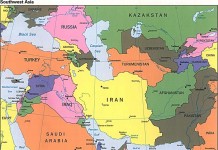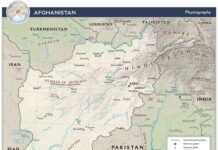Context

PoliTact has maintained that it’s the situation of Middle East especially connected with Iran, whether it involves a rapprochement or conflict, which will have a greater influence on the future direction of Afghanistan and Pakistan. This observation is based on what the history suggests; the political and religious forces exerting influence in this area have usually come from the west and from the north. While in the past, people may have been caught of-guard. In the present times, the region, particularly India, is much more aware of what this implies.
The potential switch in the Middle East balance of power will now require even bigger adjustment from these countries of South and Central Asia. However, a lot will first depend on the response of the Arab world to the rapid change and the perceived and real threats. If the West’s détente with Iran progresses; what kind of posture can be expected from the Saudis. Will it take it as a zero-sum equation, form alliances, or diversify ties with global powers.
At the macro level the regional change is associated with the shift in the traditional balance of power in the core Muslim world: amongst the Arabs, Persians and the Turks, which is also impacting the regions of the periphery. This trend has also gotten intertwined with the blooming Arab Spring and the transformation of extremism in to AQ & Associates. The anxiety regarding western intentions on reshaping the region anew is growing, and that in turn it is stressing out long established ties. Added to this complexity is the emergence of BRICS nations, which is also impacting the western strategies for the territories in question.
Analysis
The Shift in the Middle East
At the macro level the regional change is associated with the shift in the traditional balance of power in the core Muslim world: amongst the Arabs, Persians and the Turks, which is also impacting the regions of the periphery. This trend has also gotten intertwined with the blooming Arab Spring and the transformation of extremism in to AQ & Associates. The anxiety regarding western intentions on reshaping the region anew is growing, and that in turn it is stressing out long established ties. Added to this complexity is the emergence of BRICS nations, which is also impacting the western strategies for the territories in question.
This is causing that Gulf countries to become increasingly concerned about where the Arab Spring might be heading next. In addition, the Gulf States are also deeply anxious about the backlash from Syria, repercussions of dramatic changes in Egypt, and Iran’s nuclear program. There are, however, differences with in the GCC. For instance, Qataris and the Saudis have often supported different rebel groups in Syria. Moreover, when it comes to the Israeli-Palestinian conflict, Qatar has supported Hamas in Gaza, like Turkey and Iran; a move opposed by the Saudis, the new Egyptian regime, and the Israelis. These differences have also complicated US posture towards Egypt and Iran.
To further preempt the consequences of the negative trends, Saudi Arabia in particular is pushing the GCC towards a union and a confederation: to cooperate and coordinate their foreign policy and increasingly, security affairs. “We aspire to a strong union with integrated economies, a joint foreign policy and a common defense system,” Prince Salman Bin Adbul Aziz commented in December 2012 at the annual GCC Summit held in Manama, Bahrain. At the meeting, the Gulf ministers agreed on developing a unified military command and the creation of Peninsula Shield Force, which according to some will pave the way for a Gulf Army.
In March 2011, GCC offered $10 billion dollars each to the member states of Oman and Bahrain. In May 2011, GCC showed readiness to admit two other states afflicted by pro-democracy afflicted protests, Jordan and Morocco. Recently, Saudi Arabia announced an economic package of $4 billion for Egypt to stabilize the regime that got rid of Mursi.
What it Means for South Asia?
The change gripping the Middle East has already forced India, Pakistan, and Afghanistan to adjust their policies. Both India and Pakistan had to carefully craft their stances to the evolution of military interventions in the Arab world, whether it was Iraq in the past, or Libya and Syria more recently. They did so being acutely aware of the extremists and insurgencies in their own back yard. Then there are the American and European sanctions on conducting economic and energy dealings with Iran. In consideration of its strategic ties with US and Israel, India had to curtail its energy imports from Iran. Despite severe energy shortages, Pakistan is still grappling with on how to proceed with Iran-Pakistan gas pipeline project, and balance it’s ties with the Gulf States, especially Saudi Arabia, and US.
Pakistan-Gulf Cooperation
Many political and bureaucratic challenges remain in implementing the vision of Gulf Defense Cooperation. However, the Gulf States are aggressively positioning themselves to meet the emerging threats. High-level defense and security exchanges between Pakistan and Saudi Arabia have increased in recent months, and the country may be pulled in to support the defense needs of GCC, as it has been in the past, and recently in Bahrain. Other than religious affinity, Pakistan has economic interests tied up in the Gulf region; a stable region means more money in the exchequer.
According to publicly available sources, in fiscal year 2012-13, Pakistan’s remittances from the Gulf region were expected to reach $10 billion, which constituted about 61% of its total remittances. Its remittances from Saudi Arabia alone stood at $3.68 billion during 2011-12. Based on an interview that Pakistan’s ambassador to UAE Jamil Ahmed Khan gave to Khaleej Times in 2011, the volume of Pakistan’s trade with GCC is expected to increase from $59 billion to $350 billion by year 2020. However, trade volume between Pakistan and Iran is presently quite low and is estimated to reach $5 billion by 2015. This obviously will change if Iran-Pakistan pipeline project is factored in.
Talking to Arab News during a visit to Saudi Arabia in January 2013, Pakistan’s Foreign Minister at the time Hina Rabbani Khar commented, the talks “focused mainly on the roadmap and on a range of bilateral and regional issues including Syria and Afghanistan.” She went on to add, “I have intensive discussions on the roadmap that will set out a new vision of relationship between the two [Pakistan and Saudi Arabia] countries.” Little was said about the substance of the new road map inferred to by Khar.
India-Gulf Cooperation
At the same time, recognizing the growing important of BRICS, the Saudi security and economic ties with India have gone through a dramatic transformation. In 2012, it assisted in the arrest of Mumbai attack suspect Sayeed Zabiuddin Ansari, incriminating Pakistan. High-level exchanges now occur routinely between the two states. Before the imposition of sanctions, India’s trade with Iran was projected to reach $30 billion, while its business with GCC was expected to hit $150 billion in 2012-13.
However, in the backdrop of Iranian resurgence, and US reversal on Syria, senior Saudi officials have indicated that a serious rethink is taking place. While President Obama is slated to visit the Kingdom in March, it will likely be a relationship management exercise as the West continues to proceed with the Iranian détente.
The fact of the matter is that the ground reality has altered to such an extent that it appears Iran can deliver more when it comes to the fight against extremists and the Middle East peace process. Nonetheless, as long as Middle East remains in flux, managing and balancing Iranian, Turkish and Saudi anxieties will be an on going and a delicate process for Pakistan, and for that matter India and Afghanistan as well.
Afghanistan-Gulf Cooperation
The irony of the matter is that the Saudis have not supported the mainstream Islamic party Muslim Brotherhood in Egypt, but it has provided backing to similar religious parties in the peripheral regions of the Islamic world, including Pakistan. In Syria, it is assisting groups that it has control over, such as Islamic Front, against Assad government.
While Afghanistan is fighting Sunni extremists inspired by Egyptian ideologues on the one hand, it still had to keep the Iranian involvement at bay because of Western apprehensions and the sensitivities of Sunni powerhouses. How this will play out in the future would be watched carefully. The intent to include Iran in the just concluded Geneva II talks on Syria, immediately backfired. The invitation to Iran had to be rescinded due to the boycott threat from the moderate Sunni rebel fighters.
At the same time, Afghanistan, India, and Iran have been increasing their economic cooperation. India has been helping out in building the Chabahar port and better connecting Iran and Afghanistan, which also helps India in accessing Central Asia while bypassing Pakistan. Indian trade with Central Asia states was about $500 million in 2012.
The key question to examine is; in what form and fashion will the Middle East proxy war being waged in places like Iraq, Syria, Lebanon, and Yemen, shift to South Asia. Moreover, how are Pakistan, India and Afghanistan preparing to respond to or avert this? And in this, the direction of Afghanistan and Pakistan becomes pivotal. Needless to say that in the above laid out backdrop, the campaign against extremists and US-Afghan Bilateral Security Agreement takes on a lot more weigh than is commonly discerned.



